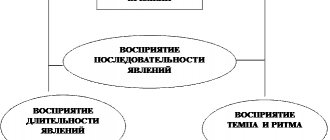Content
- Physiological mechanism of perception
- Properties of perception
- Principles of perception
- Perception factors
- Effects of perception
- Classification of types of perception
- Perceptual disturbances Illusions of perception
- Hallucinations Eidetism as a type of hallucination
If we compare the definitions of two mental processes, i.e. perceptions and sensations, then you can notice some features. For example, perception is a more complex process. If sensations reflect individual properties of objects, then perception is a holistic reflection. Thus, the result of perception is a holistic perceptual image of an object, and not a separate property of it.
New Arrivals
January 14, 2021
Ekaterina Ameyalli “Male manipulation, or about “comfortable” women”
I think many of us have watched stories like this: she thinks that they “will have everything,” while he is simply comfortable with her. He is not going to start a family with her, but he likes that she is in his life - this is how he gets attention, sex, living space, help, food or any other “bonuses”. Roughly speaking, he simply uses it for certain tasks. But sooner or later she begins to guess about the true state of things...
Read
December 17, 2015
Galina Kamarzaeva “To tolerate or not - that is the question!”
Silent means consent. Silence is gold. Are these statements really true, and are patience and silence good in all cases?
Read
November 12, 2015
Lyudmila Pototskaya “The danger of not growing up”
We have grown up. Why can’t we become adults, and we behave like little children?
Read
October 15, 2015
Elena Ponomareva “The moment in which everything worked out”
Do you remember such a moment in your life? The moment when everything literally “burned in your hands,” when you overcame anything, the moment when you wanted to run somewhere and do something, the moment in which there were no obstacles at all and as if everything impossible was possible?
Read
September 17, 2015
Yulia Brezgunova “Is it always like this?”
One friend complains to another:
“You understand, it has always been like this! It was always bad, sad, he always behaved exactly like that!”
To which the second said with amazement: “Is it always? And a year ago, and two months ago? Does he behave like this every day? And at night, even when he’s sleeping?”
Read
August 13, 2015
Alexander Stulov “Power destroys from within!”
Lately, I have begun to notice how the market for training services is actively becoming saturated with topics: manipulation, pickup, the dark sides of NLP, etc. And everything would be fine, well, it is becoming saturated, and God bless him, every person should have a choice! Everyone wants to achieve something in this life, to become someone. Some people want a happy family, some want fast career growth, and some want both.
Read
July 16, 2015
Mikhail Ozhirinsky “How to get rid of a panic attack”
More and more people began to suffer from panic attacks. Someone understands what is happening to him. Some people don’t understand at all what’s going on and have no idea what to do or how to get rid of panic attacks.
Read
June 18, 2015
"How to become creative?"
What is creativity?
First, let's figure out what creativity is. One well-known encyclopedia defines the concept of creativity as follows: “Creativity is a process of activity that creates qualitatively new material and spiritual values or the result of creating something objectively new.”
.
In other words, to create means to create.
I think we can agree with this.
Read
May 14, 2015
Alexander Alov “Leave your parents alone”
Looking at the insane number of pop psychological articles written on the topic of relationships with parents, you somehow assume that the topic has long since exhausted itself. There seems to be nothing left to add: everything has been said about insults, injuries, and other bad things. However, for some reason the problem behaves like the notorious hydra: the more often it is mentioned, the more widespread it becomes.
Read
April 16, 2015
Alexey Lanskoy “Patterns of Genius”
According to Webster's dictionary, genius is something “productive,” creative, constructive. Today the term is commonly used to denote “obvious mental superiority; rare intellectual power; in particular, excellent abilities as regards any kind of invention or the composition of new combinations."
Read
March 19, 2015
Daken Beksultanova “Responsibility for your life is the key to success!”
The world is extraordinarily fair! You can’t even imagine how much! Any situation in our life brings us certain benefits, and we pay our prices for it. With positive situations everything is clear, and there is no point in even talking about it, but negative situations are a much more interesting subject for conversation.
Read
February 26, 2015
Natalya Yudina “Addictive behavior”
Addictive behavior is not just about chemicals and/or relationships. These are any actions that a person “cannot help but perform.”
Read
February 12, 2015
Natalya Yudina “Destructive relationships”
What relationships are traumatic and need healing, and often closure?
Read
January 29, 2015
Alena Lisenkova “Rating of people’s main regrets”
Regrets about what we have done or not done sometimes haunt us.
How to live without these regrets?
Read
January 15, 2015
Natalya Rud “Is it possible to always be happy”
Lack of energy is the first sign of approaching misfortunes and illnesses. Ayurveda says that if a person is making progress in spiritual life, then this should be visible in two ways:
- A person becomes happier and happier every day.
- His relationships with other people improve.
Read
Pages: (45) [1]
All
Rate the material:
Physiological mechanism of perception
The physiological basis of perception is the processes taking place in the sense organs, nerve fibers and the central nervous system. Under the influence of stimuli at the endings of the nerves present in the sensory organs, nervous excitation arises, which is transmitted along pathways to the nerve centers, and, ultimately, to the cerebral cortex. Here it enters the sensory zones of the cortex, which represent, as it were, the central projection of the nerve endings present in the sense organs. Depending on which organ the sensory zone is connected to, certain sensory information is generated.
Since perception is closely related to sensation, it can be assumed that it, like sensation, is a reflexive process. Ivan Petrovich Pavlov showed that perception is based on conditioned reflexes, i.e. temporary nerve connections formed in the cerebral cortex when receptors are exposed to objects or phenomena.
Temporary nerve connections that ensure the process of perception can be of two types: 1. Formed within the same analyzer; 2. Interanalyzer.
The first type occurs when the body is exposed to a complex stimulus of one modality (for example, a melody). The second type of neural connections formed under the influence of a complex stimulus are connections within different analyzers, the emergence of which Sechenov explained by the existence of associations. These associations in humans are necessarily accompanied by an auditory image of the word, thanks to which the perception acquires a holistic character.
Organizational behavior. Textbook for universities | Page 1 | Online library
G. R. Latfullin, O. N. Gromova
Organizational behavior
Team of authors: V. G. Antonov, Doctor of Economics Sc., Prof., O. N. Gromova Doctor of Economics Sc., Prof., G. R. Latfullin, D.E. Sc., Prof., A. V. Raichenko, D.E. Sc., Prof. A. E. Rostovskaya, Ph.D. Sc., prof. V. G. Smirnova, Ph.D. Sc., prof. T. B. Shramchenko, Ph.D. Sc., prof. Reviewers:
Department of Economics and Management MIPK REA named after. G. V. Plekhanov (head of the department, Doctor of Economics, Professor L. M. Badalov).
A. G. Efendiev, Ph.D. Sc., Professor of the Department of Human Resource Management, Dean of the Faculty of Management of the State University of Higher School of Economics.
Introduction
Organizational behavior is a new branch of knowledge, multidisciplinary and controversial, which has developed in the United States since the 50s. XX century Currently, organizational behavior (OB) has really become a field of scientific knowledge related to the practice of effective management of modern organizations.
The main elements of OP are the individual and the group, the patterns of their behavior in a competitive environment, determined by the need for effective operation of the organization. The realization that people are becoming the most important resource of the organization led to a change in the behavioral paradigm, to the humanistic orientation of the EP, its social orientation.
Changes occurring in the external and internal environments of the organization, the emergence of new types of organizations, modern knowledge about human behavior determine the need to develop and implement in practice OP models that meet the requirements of the time. These models embody the ideas of partnership, teamwork, involvement, self-control, orientation to meeting higher-order needs, and self-realization.
The external environment of organizations is characterized by a high level of complexity, turbulence and uncertainty. Its influence on the behavior of the organization is increasing, which determines the need for constant organizational changes. Never before has there been such a high need to study the influence of the external environment on the behavior of an organization and to further develop approaches and methods for adapting to its changes.
Until recently, the international aspect of business was not so important. However, the implementation of many international projects turned out to be much more difficult than previously expected, precisely because the human factor associated with differences in the behavior of people in different cultures was not taken into account. There was an understanding of the need to study the characteristics of national cultures and their influence on OP. This trend will develop when studying the characteristics of educational programs in multinational companies, when developing methods for increasing intercultural interaction, adaptation, motivation, leadership, and decision making.
OP as an academic discipline has existed in foreign business schools since the mid-60s. XX century In our country, this discipline has been taught since 1995; it has been introduced into the higher education standard for training students and masters. However, until now there is no necessary educational and methodological support taking into account Russian practice, which significantly complicates the process of training specialists.
At the State University of Management at the department of theory of organization and management in 1999-2000. Research was conducted on the topic “Organizational behavior in modern conditions.” In 2001, the staff of the department, based on the results of a competition between the Ministry of Education and the Russian Humanitarian Science Foundation (RGNF), received the opportunity to write a set of educational and methodological materials on EP. The complex includes:
educational and methodological manual “Organizational behavior in tables and diagrams” (published in 2002);
textbook “Organizational Behavior” (published in 2004);
workshop on OP (planned to be released in 2005).
The textbook includes a disclosure of all sections of the EP course in accordance with the new educational standard of higher professional education of the Ministry of Education of the Russian Federation, taking into account the latest research in this area, as well as the practice and experience of modern domestic organizations.
The team of authors are highly qualified teachers from the Department of Theory of Organization and Management of the State University of Management, who have extensive experience in creating textbooks and teaching aids in disciplines related to EP, preparing modules and cases. For a number of years, the authors of the textbook have been teaching classes in the discipline “OP” with students, undergraduates, and graduate students of the university.
The purpose of the textbook “Organizational Behavior” is to provide students with the basics of theoretical knowledge and practical skills on modern forms and methods of influencing the behavior of an individual and a group to improve the efficiency of an organization.
Objectives of the textbook:
reveal an idea of the current state and trends in the development of educational programs;
present possible schemes for developing projects of organizational systems that place the person, his abilities and needs at the center;
reveal methods for describing the behavior of workers, groups, organizations;
show ways to change the behavior of an individual or group in accordance with the criteria for the effectiveness of the organization.
The “OP” course is closely interconnected with other educational programs and is based on the knowledge gained from studying such academic disciplines as “Fundamentals of Management”, “Organization Theory”, “Human Resource Management”, “Consumer Behavior”, “Development of Management Decisions”, “ Social Psychology".
The structure of the textbook covers the main issues of the discipline and contains thirteen chapters that correspond to the current educational standard of the Ministry of Education of the Russian Federation.
The first chapter, “Fundamentals of Organizational Behavior,” reveals a modern approach to the discipline, which consists of recognizing the priority of the individual in the organization, his knowledge, and competencies for effective work. The subject of EP, the features of EP as a multidiscipline, and the types of relationships studied in EP are presented. Behavior is considered as a function of the natural properties of the individual, conditioned by the external environment as a result of socialization, and features of virtual behavior. It is emphasized that the task of managers is to organize the effective activities of individuals and groups to achieve the common goal of the organization. In the context of OP, efficiency is determined not only by economic indicators, but also by indicators of quality, satisfaction, flexibility, competitiveness and development.
The second chapter, “Perception and Attribution,” reveals the main theories of individual behavior in an organization and pays significant attention to such issues as perception and attribution of the individual. Perception is viewed as the process by which an individual assigns meaning to elements and phenomena of the external environment. Perception is used by the individual to select, store, and interpret stimuli into a meaningful and logical picture of the surrounding world. The same information is perceived differently by each individual, and its interpretation determines the individual's behavior. What matters is not what happens, but how it is perceived. Perception determines the further behavior of the individual. The essence of attribution theory is revealed, which allows us to determine the causes of individual behavior.
The third chapter , “Personality in an Organization,” is devoted to revealing issues related to the characteristics of individual behavior in an organization. A formal dynamic model of personality is presented and it is shown how the natural properties of a personality influence its behavior in an organization. The issues of formation of personality attitudes and their significance in the organization of behavior are covered.
The fourth chapter, “Motivation and Performance,” defines the essence and content of motivation, reveals the processes of formation and use of motives, and shows the mechanisms of motivation in organizations. Using models and specific examples, the interaction of motivation and stimulation is revealed, and the concept of motivation effectiveness is substantiated.
The fifth chapter , “Formation of group behavior in an organization,” shows the role and importance of group work in the effective functioning of an organization. It is revealed that the objective need of the individual for involvement and communication can only be realized in a group. Particular attention is paid to the factors influencing the functioning of groups (formal and informal), as well as the peculiarities of the formation of various types of groups, their influence on the behavior of individuals, and new forms of group interaction in the form of self-managed teams. When groups function, intergroup conflicts often arise. These conflicts are inevitable in the activities of any organization; they can have both positive and negative consequences, depending on the impact on the achievement of their goals. To reduce negative consequences, it is necessary to be able to correctly identify the causes of conflicts, manage their course and resolution, and reduce the level of conflict confrontation. The achievement of group goals, satisfaction of group members with their work, and individual development of group members are considered as criteria for the effectiveness of group activities.
Properties of perception
1. Objectivity of perception
This is the ability to reflect objects and phenomena of the real world not in the form of a set of unrelated sensations, but in the form of individual objects. Objectivity is not an innate property of perception. The emergence and improvement of this property occurs in the process of ontogenesis, starting from the first year of a child’s life. According to Ivan Mikhailovich Sechenov, objectivity is formed on the basis of movements that ensure the child’s contact with the object (hand movements; eye movements that trace the contour of the object, etc.). Without the participation of movement, images of perception would not have the quality of objectivity.
2. Integrity of perception
Perception gives a holistic image of an object. It is formed on the basis of generalization of information received in the form of various sensations about the individual properties and qualities of an object. The components of sensation are so strongly interconnected that a single complex image of an object arises even when only individual properties or individual parts of the object directly affect a person. This image arises conditionally as a result of the connection between various sensations.
The integrity of perception is expressed in the fact that even with incomplete reflection of individual properties of the perceived object, the received information is mentally completed into a holistic image of a specific object.
3. Structurality of perception
The structure of perception is not just a collection of sensations. It reflects the relationship between various properties and parts, i.e. structure of the subject. Perception brings to our consciousness the structure of an object or phenomenon that we encounter in the real world. We can say that the structure of perception is a reflection of the specific relationship of the elements of the whole. For example, notes enter consciousness, and we recognize the melody, we recognize the triangle in the figure, because we know the aspect ratio of a given figure, or a certain letter remains the same letter despite a different writing style.
Structurality is associated with another property of perception - integrity.
4. Constancy of perception
Constancy is the relative constancy of the image of an object when the conditions of its perception change (for example, a car seems large to us at any distance from it). Constancy is observed to the greatest extent in the visual perception of color, size and shape of objects. Thanks to constancy, which manifests itself in the ability of the perceptual system (a perception system that consists of a set of certain analyzers) to compensate for changes in the conditions of perception, we perceive the objects around us as relatively constant.
A person repeatedly perceives a certain object, and this object is perceived under completely different conditions. This allows the system to maintain relative constancy of the properties of objects and phenomena. Without constancy of perception, people would not be able to navigate the world around them.
5. Apperception
Apperception is the dependence of perception on past experience and personality traits of the perceiver. A person’s knowledge and previous experience play a huge role in apperception. In the process of perception, in order to classify what you perceive, you will put forward and test hypotheses about whether an object belongs to a particular category of objects.
Thus, during perception, past experience is activated. Therefore, one object can be perceived differently by different people. The content of perception is determined by the task, motives of activity, interests. An essential place in apperception is occupied by attitudes and emotions, which can easily change the content of perception.
6. Meaningfulness of perception
Meaningfulness of perception is the property of human perception to endow the perceived object with a certain meaning. Perception is not determined simply by a set of stimuli, but is a constant search for the best interpretation of the data received.
We perceive objects that have a certain meaning. Regardless of the constantly changing content, we learn the same subject. Human perception, being a kind of awareness of objects and phenomena, includes the act of understanding and comprehension.
7. Activity (selectivity) of perception
Selectivity of perception lies in the fact that at any given time we perceive only one object or a specific group of objects, while other objects in the surrounding world are the background of our perception (not reflected in consciousness).
For example, while in a lecture hall, you listen to a lecture without noticing that someone behind you is discussing plans for the evening. Your perception is directed towards the lecture until you are asked about your plans. In this case, you will already be communicating and not listening to a lecture, i.e. perception will be directed towards the interlocutors.
The idea of another person is closely related to the level of one’s own self-awareness. Analysis of self-awareness through another person is carried out using two concepts: identification and reflection.
Identification is one of the mechanisms of cognition and understanding of a person, which consists in unconsciously likening oneself to a significant other.
Here, a significant other is a person who is an authority for a given subject of communication and activity. This usually happens when, in real interaction situations, an individual attempts to put himself in the place of a communication partner. During identification, a certain emotional connection is established with the object.
Developmental Assessment Find out more
It is necessary to distinguish between the concepts of “identification” and “reference”. If for the first concept the basis is the process of assimilation of the subject to a communication partner, i.e. assimilation to a significant other, then for the second concept (“reference”) the main thing is the subject’s dependence on other people, acting as a selective attitude towards them. The object of reference relations can be either a group of which the subject is a member, or another group with which he relates himself without being a real participant. The function of a referent object can also be performed by an individual person, including one who does not really exist (a literary hero, a fictional ideal to follow, etc.). In both cases, the subject borrows for himself goals, values, ideas, norms and rules of behavior of the object of reference (group, individual.
The concept of “identification” is close in content to the concept of “empathy”.
Empathy is the understanding of a person’s emotional states in the form of empathy. The mechanism of empathy is similar to the mechanism of identification.
This similarity lies in the ability to put oneself in the place of another, to look at things from his point of view. However, this does not necessarily mean identifying with that other person (as identification does). Simply, with empathy, the partner’s line of behavior is taken into account, the subject treats him with sympathy, but interpersonal relationships with him are built based on the strategy of his line of behavior.
Reflection is the individual’s awareness of how he is perceived by his communication partner, that is, how his communication partner will understand me.
During interaction, certain characteristics of each other are mutually assessed and changed.
Effects of Interpersonal Perception
Causal attribution
People, getting to know each other, are not limited to obtaining information through observation. They strive to find out the reasons for the behavior of communication partners and clarify their personal qualities. But since information about a person obtained as a result of observation is most often insufficient for reliable conclusions, the observer begins to attribute probabilistic causes of behavior and characterological personality traits to the communication partner. This causal interpretation of the behavior of the observed individual can significantly influence the observer himself.
Thus, causal attribution is the subject’s interpretation of the interpersonal perception of the causes and motives of other people’s behavior. The word "causal" means "caused". Attribution is the attribution of characteristics to social objects that are not represented in the field of perception.
see also
I myself am happy to be deceived...
Based on a study of problems associated with causal attribution, researchers have concluded that attributional processes constitute the main content of interpersonal perception. It is significant that some people tend to fixate physical traits to a greater extent in the process of interpersonal perception (in this case, the scope of “attribution” is significantly reduced), others perceive predominantly the psychological character traits of others. In the latter case, a wide scope for attribution opens up.
A certain dependence of “attribution” on the attitude in the process of perceiving a person by a person has been revealed. This role of attribution is especially significant when forming a first impression about a stranger. This was revealed in the experiments of A.A. Bodaleva. Thus, two groups of students were shown a photograph of the same person. But first the first group was told that the man in the photograph shown was a hardened criminal, and the second group was told about the same person that he was a prominent scientist. After this, each group was asked to create a verbal portrait of this person. In the first case, the corresponding characteristics were obtained: deep-set eyes testified to hidden anger, a prominent chin - to the determination to “go to the end in a crime,” etc. Accordingly, in the second group, the same deep-set eyes spoke of deep thought, and a prominent chin — about willpower in overcoming difficulties on the path of knowledge, etc.
Such studies should answer the question about the role of the characteristics given to communication partners in the process of interpersonal perception, and the degree of influence of attitudes on these characteristics.
Halo effect (halo effect)
Forming an evaluative impression of a person in conditions of a lack of time to perceive his actions and personal qualities. The halo effect manifests itself either in the form of positive evaluative bias (positive halo) or negative evaluative bias (negative halo).
So, if the first impression of a person is generally favorable, then in the future all his behavior, traits and actions begin to be reevaluated in a positive direction. In them, only positive aspects are highlighted and exaggerated, while negative ones are underestimated or not noticed. If, due to the prevailing circumstances, the general first impression of a person turns out to be negative, then even his positive qualities and actions in the future are either not noticed at all or are underestimated against the backdrop of hypertrophied attention to shortcomings.
Effects of novelty and primacy
Closely related to the halo effect are the effects of novelty and primacy. These effects (novelty and primacy) are manifested through the significance of a certain order of presentation of information about a person to form an idea about him.
The novelty effect occurs when, in relation to a familiar person, the most significant is the latest, i.e., newer information about him.
see also
Stereotypes about generational differences or how to approach any employee
The primacy effect occurs when, in relation to a stranger, the first information is more significant.
All the effects described above can be considered as special cases or variants of the manifestation of a special process that accompanies the perception of a person by a person, called stereotyping.
Stereotyping
Perception and evaluation of social objects based on certain ideas (stereotypes). Stereotyping is the attribution of similar characteristics to all members of a social group without sufficient awareness of the possible differences between them.
A stereotype is a simplified, often distorted, idea of a social group or an individual belonging to a particular social community, characteristic of the sphere of everyday consciousness.
A stereotype arises from limited past experience as a result of the desire to draw conclusions based on insufficient information. Most often, stereotypes arise regarding a person’s group affiliation.
Stereotyping is one of the most important characteristics of intergroup and interpersonal perception and is accompanied by manifestations of social attitudes, halo effects, primacy and novelty. In interpersonal perception, stereotyping performs two main functions:
1) maintaining identification;
2) justification of possible negative attitudes towards other groups.
Particularly widespread are the so-called ethnic stereotypes, when, based on limited information about individual representatives of certain ethnic groups, preconceived conclusions are drawn about the entire group. Stereotyping in the process of people getting to know each other can lead to two different consequences. On the one hand, to a certain simplification of the process of knowing another person, and then this simplification leads to the replacement of the image of a person with a cliche, for example, “all accountants are pedants,” “all teachers are supervisors.” On the other hand, this leads to prejudice if a judgment about a social object is based on limited past experience, which most often may turn out to be negative.
Attraction
When people perceive each other, certain relationships are formed with the inclusion of emotional regulators - from rejection of a particular person to sympathy, friendship, love.
Social attraction is a special type of social attitude towards another person, in which positive emotional components predominate.
There are three main levels of attraction: sympathy, friendship, love. Attraction manifests itself in emotional appeal, the attraction of one person to another.
Mutual understanding of communication partners presupposes that each of them knows the psychology of the other person: his value orientations, motives and goals of activity, the level of aspirations and attitudes, character traits, etc. People have varying degrees of ability to communicate and to develop interpersonal sensitivity. These abilities can be developed and improved in the process of conducting socio-psychological training on interpersonal sensitivity. Currently, in the practice of foreign psychology, so-called T-groups are organized (T is the initial letter of the word “training”), in which interpersonal sensitivity training is carried out. Social and psychological trainings are organized using sensitive methods. The sensitive method belongs to the category of interpersonal sensitivity methods. The main goal of sensitivity training is to develop and improve the ability of individuals to understand each other.
Participants should not previously know each other. When forming a group, there is no attempt to structure it based on education, position, qualifications or profession. During such training, participants are included in a completely new sphere of social experience for them, thanks to which they learn how they are perceived by other group members and have the opportunity to compare these perceptions with self-perception.
- Tweet
Principles of perception
A group of psychologists, together with Max Wertheimer, a German psychologist and founder of Gestalt psychology, formulated the laws of perception, which became the theoretical basis of Gestalt psychology.
1. The principle of proximity Elements that are close to each other in space and time and that seem to us to be united in groups, we perceive together.
2. Principle of Continuity There is a tendency to follow a direction that allows observed elements to be linked into a continuous sequence or a specific orientation. In the figure we see not just individual dots, but two intersecting lines.
3. Principle of similarity Similar elements are perceived by us together, forming closed groups. Because of the color, we perceive the points in the figure as rows rather than columns.
4. Closure principle There is a tendency to complete unfinished items and fill empty spaces.
5. The principle of simplicity (the law of content, the principle of good form, the law of pregnancy) We perceive and interpret composite or complex objects as the simplest form or a combination of the simplest forms. In the figure we see three different simple figures, and not one complex one.
Pregnant gestalt means that in any conditions we strive to see the figures as complete as possible.
6. Figure-ground
We strive to organize our perception in such a way as to see the object (figure) and the background against which it appears. The object is brighter, more significant, and noticeable.
Two features of perception
The first feature is due to the fact that the subject and object of interpersonal perception (in this case, people) are fundamentally similar. Hence, the individual (subject of perception), when making a conclusion about the state or intentions of another person, is maximally inclined and has the opportunity to use his own experience.
In other words, we assume that another person's experience resembles our own to some extent, and this assumption helps us perceive it more accurately. For example, if I know that my colleague has returned from a funeral, then my own past experiences enable me to interpret his silence as depression rather than as indifference or resentment towards me. True, this same ability of ours can lead to serious errors of perception, causing problems in mutual understanding.
The second feature is due to the following. If a person makes a mistake when perceiving an object (for example, he mistakes artificial flowers for real ones), then he can quite easily correct it by performing actions with this object that will allow him to detect the error.
An error in the perception of another person or misconceptions about his goals or intentions is much more difficult not only to verify, but also to correct. At the same time, the perceiver often does not set himself the task of clarifying or verifying his idea, sincerely considering it to be correct. Of course, sometimes people correct each other's perceptions, but more often one mistake leads to another, significantly influencing the subsequent nature of interpersonal communication.
SEE ALSO: How persistent and popular stereotypes of perception help and hinder your life
So, the main regulator in building communication is the image of the partner, the idea of him that everyone has. It is to this image that communication messages will be addressed. When forming it, the first impression of a person is important.
Each of us has our own ideas and judgments about people, the world, and ourselves; plans that need to be implemented in the future, etc. All this can somehow affect the first impression of another person.
The question of the degree of objectivity of the emerging first impression is related to the question of the role of understanding the communication situation in constructing the image of another. In different situations, we need such ideas about our partner that would help us build our behavior and communication with him.
In specific conditions, you don’t need to know what kind of person “in general” is; you need to imagine how he will manifest himself in a given situation, what to expect from him now, with given goals, objectives, desires, in a given context. Communication is not built “in general,” but “here and now,” and the idea of a partner should reflect this reality.
Many situations demonstrate the dramatic impact of first impressions on perception, which can influence subsequent communication between people. This impact can be enhanced by some psychological characteristics of the participants in communication. Let's point out some of them.
Perception factors
Our perception depends on external and internal factors.
a) External factors: - intensity of the stimulus; — size of the stimulus; — stimulus contrast; - movement of the stimulus; - recognition of the stimulus.
b) Internal factors: - human attitude; — needs; - experience; — personal characteristics (self-esteem, left- or right-handedness, optimism-pessimism, etc.); - effects of perception.
Effects of perception
Let us highlight the main effects (errors) of perception:
The projection effect is the ability of people to attribute their own advantages to a pleasant person, and their shortcomings to an unpleasant person. Those. the effect suggests that other people have the same qualities as the perceiver.
The halo effect is the formation of a specific attitude towards a person through the directed attribution of certain qualities to him; information received about a person is superimposed on the image that was created in advance. Those. the effect is to extend the general opinion to the particulars.
The primacy and recency effect is the tendency of people, when faced with conflicting information about another person, to give more weight to information received first (if a stranger is perceived) or more recent information (if an old acquaintance is perceived).
The effect of physiognomic reduction is the ability of people to draw conclusions about the character and psychological characteristics of a person based on the features of his appearance.
Halo effect
“Ivanov once took me across the road, which means he will be an excellent deputy.” “Sergeev only gets straight A’s, he couldn’t break the window with the ball.” These exaggerated examples are based on the so-called halo effect, which in psychology is a cognitive distortion in which individual positive signs become the basis for an overall assessment of a person. When someone seems attractive to us, we tend to consider him more successful, kind, empathetic, and friendly than an unattractive one.
The halo effect (halo effect) can also have another side, which is called the devil effect. It occurs when, of two suspects (attractive and unattractive), the unattractive one is more decisively accused of committing a crime.
Psychologist Edward Thorndike wrote about the halo effect in 1920 in his article “A Constant Error in Psychological Ratings.” He conducted a study and revealed the presence of this phenomenon. Later, various scientists conducted their experiments, which confirmed his theory. Thorndike originally coined the term in relation to people, but its use has expanded significantly, especially in the field of brand marketing, which we will discuss later.
In the original experiment, Thorndike asked two commanders to rate their soldiers in terms of physical qualities (neatness, voice, fitness, energy), intelligence, leadership skills, and personal qualities (reliability, loyalty, responsibility, dedication, cooperation). His goal was to see how ratings of one characteristic affected others. And there really was a direct relationship - those who received the highest ratings for physical characteristics were rated higher in other parameters.
Some more examples of the halo effect:
- The job seeker who seems more attractive gets the job.
- A laptop with a better design seems more functional than one with an understated design.
- People with good looks seem more intelligent.
- Juries have difficulty being convinced that a nice person is guilty of a crime (John Monahan Study, 1941).
It should be said that some researchers and scientists believe that the halo effect has reasonable grounds. For example, that intelligence and beauty are inherited. However, practice shows that this is not always the case.
A 2011 study by psychologists Moore, Philippou, and Perrett found that the halo effect may also affect opinions of intelligence. That is, if a person considers another person smart, he attributes other positive qualities to him: friendliness, sense of humor, leadership qualities. This experiment expands on the concept of the halo effect.
Halo effect in advertising
The term "halo effect" is used in marketing to explain the tendency of customers to buy certain products because of favorable experiences with other products manufactured by the same company.
The halo effect is also present in the field of brand marketing. The main effect is that the perceived positive properties of a particular item are transferred to the wider brand. A notable example is how the popularity of Apple's iPod sparked enthusiasm for the company's other products.
Another example is Subway's brand image as a "healthy" variety of fast food. Perceiving a restaurant as “healthy” causes consumers to underestimate the calorie content of its dishes.
Marketers use the halo effect to sell products and services. When a celebrity endorses a particular product, that person's positive evaluation can influence the perception of the product itself. True, there is one problem with stars: if they get into a scandal, this can also turn consumers away from this product and then we are dealing with the other side of the halo effect.
Designers often take advantage of this effect when they sacrifice simplicity and functionality for the sake of a beautiful image. True, this often does not work in the long term, because such a strategy damages the reputation. Apple technology has conquered the whole world, not least thanks to its simple design.
If you want to learn more about the halo effect, we recommend that you read a book on the topic: The Halo Effect...and Other Eight Illusions That Mislead Managers.
Effects of perception
Of course, the halo effect is not the only one when it comes to how others perceive a person. We all have some patterned inaccuracies. These effects occur for two different reasons:
- Behind them are some internal patterns of social perception.
- People see what is happening this way because in this society it is so accepted and so familiar to everyone.
The most well-known perceptual distortions are:
- False Consent Effect : This is the tendency to project your way of thinking onto other people. In other words, people tend to believe that others think the same way they do.
- Psychological Projection: A defense mechanism that people subconsciously use to cope with difficult feelings or emotions by attributing them to others. We assume that other people have the same qualities as ourselves.
- Actor-observer effect : the tendency to explain one’s own mistakes and miscalculations by the peculiarities of the situation, and the troubles happening to others by the negative qualities of their personality. Often manifests itself in relationships between drivers.
- Role effect : Role-driven behavior that we often mistake for personality traits. For example, we perceive a boss who rightly criticized poor work as an unpleasant person.
- In-group favoritism : This is the tendency to believe that members of one's own group are better, smarter, and fairer. The same effect works when a person is similar to us.
- Causal attribution effect : we often attribute situational motives to common behavior of people, and personal motives to non-standard behavior. We attribute our successes to ourselves, and our failures to the current situation. For other people's successes and failures, it's just the opposite.
- Authority effect : the opinion of an authoritative person seems more significant to us, even if he is not a professional in the field of interest to us.
- Primacy effect : the first information is overestimated in comparison with the subsequent one.
- Effect of physiognomic reduction : the conclusion about the presence of a psychological characteristic is made on the basis of appearance features.
- Expectation effect : when we expect a certain reaction from a person, we provoke him to it.
- Presumption of reciprocity : the tendency of a person to believe that "the other" treats him the way he treats the "other".
- Condescension effect : the boss exaggerates the positive traits of his subordinates and underestimates the negative ones.
- Hyper-demanding effect : the boss underestimates the positive traits of his subordinates and exaggerates the negative ones.
- Loser effect : a person who has failed, those around him begin to consider him a loser in all other matters.
- Effect of logical error : consists in the falsity of judgments about the constancy and close relationship of any personality qualities (for example, courtesy and good nature, kindness and empathy).
- Mean error effect : the tendency to soften judgments of another person's salient features toward the average.
- Superiority effect : people tend to overestimate the various qualities of those people who are superior to them in some important parameter for them.
As we can see, a person makes a huge number of mistakes when it comes to the perception of other people. However, remember that some cognitive distortions can also have positive consequences. There is no clear recipe for what is right and what is wrong. Sometimes delusions can lead us to success, and rigid rationality can turn others away from our society.
Did you like the article? Join our communities on social networks or our Telegram channel and don’t miss the release of new useful materials: TelegramVKontakteFacebook
We also recommend reading:
- Storytelling
- Not everything is what it seems
- Restorff effect
- Sleeper effect
- Reverse effect
- Social perception
- 7 cognitive distortions that prevent you from making good decisions
- My own psychologist
- Barnum effect and Forer experiment
- The effect of joining the majority
- Doctor Fox Effect
Key words:1Communications, 4Communications
Classification of types of perception
1) Separation by modality: - visual perception; - auditory perception; - tactile perception; - taste perception; - olfactory perception. Combinations of different types of perception are possible.
2) Division by object of perception: - perception of space (includes the perception of size, shape, relative position of objects, their relief, distance and direction); — perception of time (reflection of the duration and sequence of phenomena or events); — perception of movement (reflection of the direction and speed of the spatial existence of objects); — perception of speed; - perception of direction; - perception of a work of art; - perception of the main phenomena of human life.
3) Separation by goal: - intentional (voluntary) perception (we are guided by a previously set goal or task); - unintentional (involuntary) perception (lack of volitional activity and purpose).
4) Division according to the participation of other psychological formations: - emotional perception (perception associated with emotions and feelings); — rational perception (perception subordinate to the thinking process).
Interpersonal perception
Interpersonal perception. (interpersonal perception) The impressions we form about other people serve as an important basis for interpersonal interactions. People's perceptions. - Is a complex and distinctly different object from the perception of space. In this case, the attention of the human observer is directed to the internal psychological processes of the human stimulus. These processes are practically undetectable by sensory mechanisms; information about them is obtained through inferences or attributions made by the observer. In this sense, "human perception" is not a good name, and the process might better be called "inferences about people." Most of the topic M.V. is now covered by attribution theory. Fritz Heider pointed out 3 differences in the perception of physical objects and people. First, people are believed to have an inner life, as opposed to physical objects. Every person has thoughts and experiences emotions, believing that others are no different from him in this regard. Second, physical objects are not perceived as the cause of their own actions, whereas people are often seen as the primary causes of their actions. The concept of responsibility is closely related to the idea that people are guided in their actions by their own internal considerations, and not simply subject to the inexorable demands of their environment. Third, humans can deliberately manipulate and exploit observers, but inanimate objects cannot. One of the purposes of human perception is to enable a human observer to predict the likely actions of a human stimulus in order to take them into account when planning his own actions. The study of human perception is essentially an attempt to reconstruct the way the average person on the street processes information about other people and about themselves. Such an observer is interested in answering the question of why a given human stimulus acts or behaves the way it does. According to Haider, the causes of behavior are usually attributed either to the environment or to the actor himself.
When an action can be attributed to environmental causes, the subject is not held responsible for the positive or negative consequences of his behavior, but when individual internal factors are perceived as the sources of behavior, the subject in question is fully responsible for those consequences. Much of the work on attribution research has focused on the rules that observers use when attributing the causes of behavior to the environment or to the actor himself. Heider believed that the interpersonal function of human perception is to enable the observer to predict and control the behavior of other people. The tendency of observers is to accept the first suitable cause as the basis of behavior. However, if there are other probable reasons, the influence of a particular reason on achieving the effect is devalued. This principle of devaluation can lead to the attribution of both environmental and personal reasons for observed behavior. Moreover, the more effects associated with an agent's behavior, the more plausible the reasons may be. G. Kelly, who proposed this discounting principle, supplemented it with the augmentation principle. The more a person risks spending to act as he does, the more likely it is that the observer attributes his behavior to internal, personal reasons. In general, the more an observer believes that an actor's behavior differs from the behavior of most other people in a similar situation, the more that behavior will be attributed to something unique (or is attributed) to that actor. The observer may see the actor's behavior only once, or he may have unlimited opportunities to observe it. Most attribution rules can be based on either a single observation or multiple observations.
The first case includes the following. Behavior out of role. Extra-role behavior can be interpreted as a derivative of the principle of reinforcement. A person who violates role boundaries thereby gives up habitual rewards and appears willing to accept further negative reactions from others. Thus, in doing so, he must be guided by certain personal considerations. Non-general effects (popsottop effects). An observer can mentally reconstruct another person's decision-making process to understand the reason for their choice. It can be assumed that the chosen alternative is preferred because it maximizes some value for that person, at least relative to other alternatives, i.e. The basis of a decision is some effect that is not common to the possible decision alternatives, and this effect allows us to learn something about the person making the decision. Hedonic meaning. If another person's behavior has a certain positive or negative effect on the observer, then the observer will be more inclined to attribute that behavior to personal reasons. Personalism. When an observer experiences positive or negative effects of an actor's behavior, the observer may wonder whether these effects were specifically intended for the observer. If the observer believes that the behavior in question was directed at him (personally) or against him (her), then he is more confident in making personal attributions. G. Kelly also provided his model with a set of rules that naive observers can use to guide their selection of attributes as a result of multiple observations of an actor. If the observer does not have a preconceived cause-and-effect framework upon which certain behaviors are analyzed, reasons given, and graded according to proficiency, he will apply a rational process for processing the available data, similar to that used by researchers. According to Kelly, the following principles allow an observer to attribute the causes of behavior to the actor, the environment, or both.
Subsequence. A consistent response indicates a stable environmental cause, while an inconsistent response indicates fluctuations in personal factors. Vagueness. In general, the more differentiated the response is across different objects, the more likely the observer is to attribute it to environmental factors, and the less differentiated the response, the more likely it is to be a personal attribution. Consistency (consensus). If the majority of people react to a situation in the same way, then this makes it easier to assign environmental status. But if a particular person reacts differently than most people, then personal attribution is more likely. There is a tendency to distinguish between the attributes of the agent and the observer. Actors tend to view their own actions as forced, arising under strong pressure from external circumstances. On the contrary, as Heider writes, the actor's behavior tends to fill the observer's field of perception. This actor-orientation, by relegating the role of the environment to the background, leads observers to rely more often on personal attributes than on the actor, which has been called the fundamental attribution error. Moreover, subjects naturally have more information about themselves and a broader context in which to make attributions than observers. I. Jones and C. Davis argues that once an observer makes an attribution of personal causes, a correlational inference is made from the observed behavior and an inference is made about the motive underlying the behavior. The observer will note environmental influences and observe possible correlations with behavior.
If behavior is associated with environmental factors, then information processing stops. However, in the case of personal attribution, the researcher may assume that the actor intends to produce the observed effects. Intention implies that the actor is aware of possible consequences in advance and is able to cause them. Intention does not refer to observed behavior, but to its consequences (outcomes and consequences). When an intention is attributed to an actor, the motive behind that intention is sought. Correlational inference assumes a commonality between the type of response and the motive attributed to it. According to this theory, an observer's attribution of the causes of behavior is always followed by a subsequent correlational inference. It is further assumed that recognition and labeling of responses is an unproblematic and natural mechanism, similar in many ways to the action of proximal forces of the perceptual field. It is argued that action cannot be identified separately from the goals by which the subject is supposed to be guided. It is clear that observers form complex (summative) impressions of others. Sources of information include direct observations and reports from other observers. Some types of information play a more important role in the formation of such summative impressions, while others are more peripheral or insignificant. Norman Anderson has proposed mathematical models of how observers process and weigh information about actors provided to them (in adjectival form). For example, how much more weight might be given to certain characteristics over others when judging a person's likability, or how much more weight might be given to early information compared to later information.
Perception disorders
1) Illusions are erroneous perceptions of real objects and phenomena. They can be auditory, visual, olfactory, etc.
Under certain conditions, they occur in most people and can be caused by physical (perception of a spoon in a glass of tea that appears broken), physiological (split images of objects if you press on the side of the eyeball at the moment of perception) and psychological reasons (overestimation of vertical lines compared to horizontal ones) .
Illusions of perception
a) Ebbinghaus illusion
This is an optical illusion of perception regarding size. Two objects of the same size can look different. If one object is placed among smaller objects, it will appear larger than if the same object is placed among larger objects.
b) Ponzo illusion
This is an optical illusion of perception. Mario Ponzo suggested that the human brain determines the size of an object by its background. He drew two identical segments against the background of two converging lines, like a railway track stretching into the distance. As a result, horizontal lines are perceived differently.
c) Aristotle's illusion
This is an illusion of touch. A small object (pencil) is placed between (under) crossed fingers (it’s easier to use the middle and index fingers) so that it touches one finger on the inside and the other finger on the outside. When you move your fingers (and hand) over an object (back and forth), after a while you get the impression that your fingers are touching 2 objects.
d) Zellner illusion
An optical illusion in which parallel lines intersected by a series of short diagonal lines appear to diverge.
e) Müller-Lyer illusion
An optical illusion that occurs when observing segments framed by arrows. The segment framed by the “points” seems shorter than the segment framed by the “tail” arrows.
f) Poggendorff illusion
An optical illusion where the red line is a continuation of the black line, rather than the blue one.
Hallucinations
2) Hallucinations are erroneous perceptions in the absence of an object.
Hallucinations occur with alcohol abuse (delirium delirium), drugs, psychostimulants (LSD, cocaine, etc.), medications (for example, antidepressants), mental illness (schizophrenia, epilepsy), organic brain lesions, cataracts (Charles hallucinations). Bonnet).
Stereotyping
Social stereotypes are the basis for the formation of first impressions, and social stereotyping is the main mechanism of this process. A social stereotype is a stable idea about any phenomena or people, characteristic of representatives of a particular group. Any social stereotype is the product of a certain group of people, and an individual uses it only if he considers himself to be part of this group.
The difficulty lies in the fact that the visible bearer of a particular stereotype is always a specific individual. Therefore, when explaining the origin and function of a stereotype, they often try to proceed from the study of a person’s experience, his knowledge about the subject of the stereotype, i.e. from his individual characteristics. This leads to the incorrect conclusion that social stereotypes are a consequence of limited experience, ignorance, and the fruit of hasty generalizations. However, such explanations contradict not only research data, but also facts known to most people.
Wherever different groups can be distinguished, there are also stereotypes that determine the ideas of these groups about each other, and they can only be adequately used in intergroup relations to quickly navigate the situation and identify people as representatives of different groups. Orientation and determination occur instantly: based on signs of group affiliation, the stereotyping mechanism is triggered and the corresponding social stereotype is updated. To trigger this mechanism, it is completely unimportant what is actually happening, what is the personal experience of the owner of the stereotype; The main thing is not to make a mistake in orientation.
ALSO SEE: Proxemics: correct distance and spacing in different communication situations
Situations of the first meeting relate specifically to the intergroup level of communication. Since the main thing in it is to resolve the issue of the partner’s group affiliation, the most important characteristics of the partner are those that allow him to be classified into some category or group. It is these characteristics that are perceived most accurately. All other traits and characteristics of an individual are simply completed according to certain schemes. If communication is limited for some reason only to the intergroup level, then such a scheme of perception always leads to success.
At the same time, stereotyping presupposes a certain assessment of the properties and qualities of his partner that are unknown to the perceiver, which can lead to inadequate communication in the future, beyond the situation of the first meeting, when accuracy in determining precisely these unobservable psychological qualities is required.
Thus, the perception of another is always simultaneously true and false, correct and incorrect, more accurate in relation to the main characteristics at a given moment and less accurate in relation to others. This is why it takes extra effort to see both the similarities and differences between people.
It is important to note the following. Almost every adult who has sufficient communication experience is quite capable of accurately determining the most significant characteristics of a partner - his socio-demographic and professional background, and psychological traits.
However, this accuracy is high only in neutral circumstances, when all possibilities of interaction, communication, and dependence between people are eliminated and the only task is the accurate and complete perception of the other person. The less neutral the relationship, the more people are interested in each other for one reason or another, the higher the likelihood of mistakes.
Among people who are able to more accurately judge and understand the behavior of others, there are more often those who:
- base their conclusions on observation of behavior rather than on stereotypes;
- less authoritarian personalities;
- more objective about themselves.
Thus, failures and failures in interpersonal communication often occur because, firstly, people perceive each other incorrectly and inaccurately; secondly, they do not understand that their perceptions are inaccurate. Although it would be an illusion to believe that more accurate perception always leads to more successful communication. However, satisfaction with communication in both short-term and long-term relationships largely depends on the degree of adequacy and depth of interpersonal perception.
Only practical modern knowledge and skills. Learn only what you are interested in and need with a discounted subscription.
Explore today
Conflictology
Memory development
Project management
Etiquette and business communication skills
Budgeting and intra-company planning
Dissection cadaver course on injection and thread techniques in cosmetology. Day three: live injection master class
Advertising: creation, planning, placement
Creativity and Intelligence: Developing Creative and Analytical Abilities
Sales technologies: how to sell a lot










